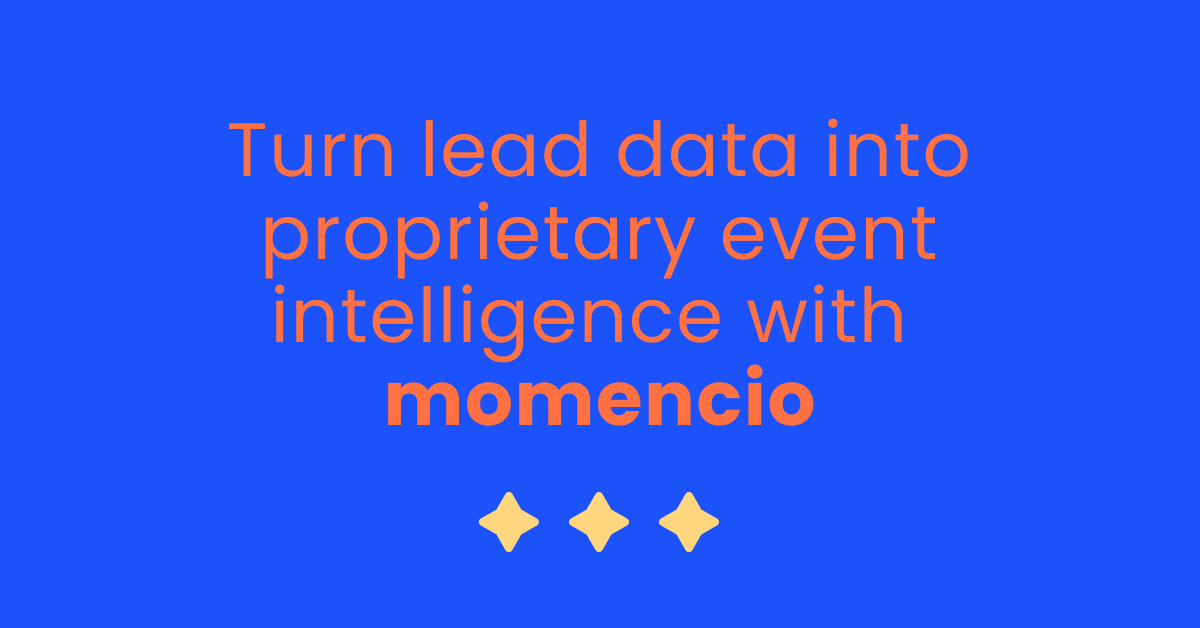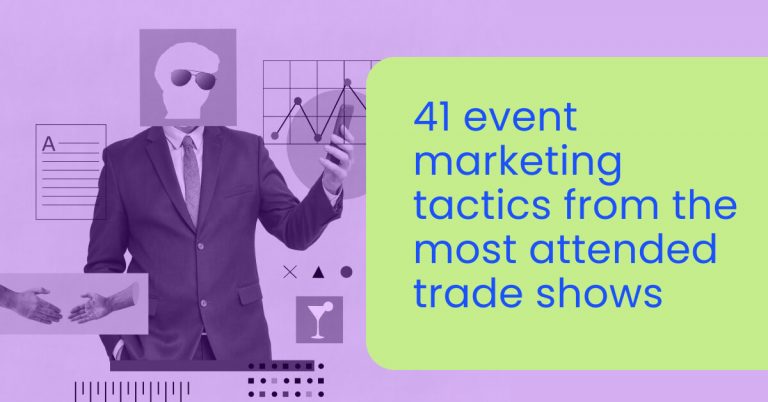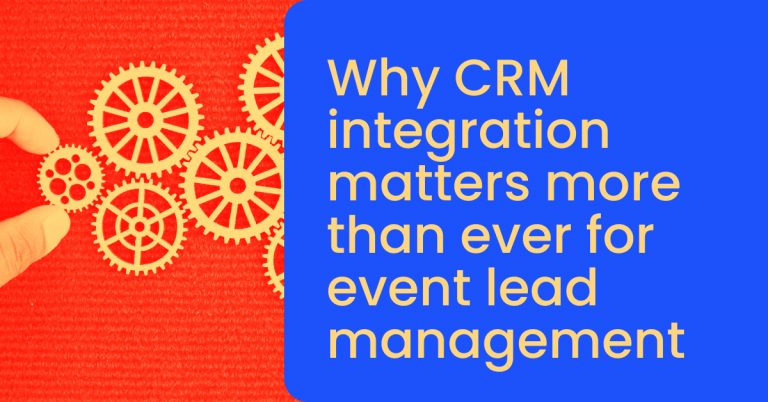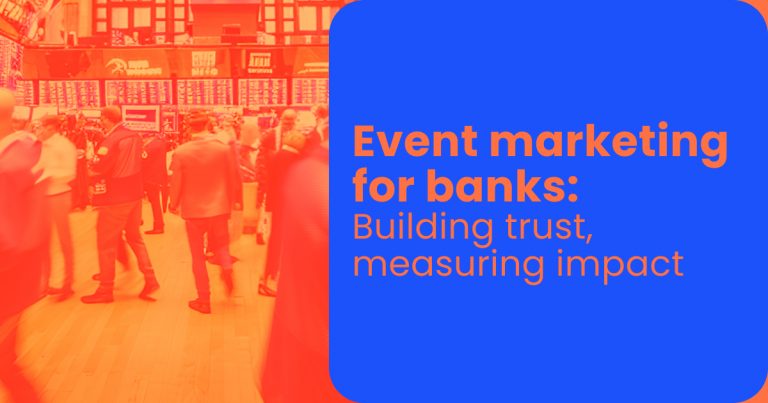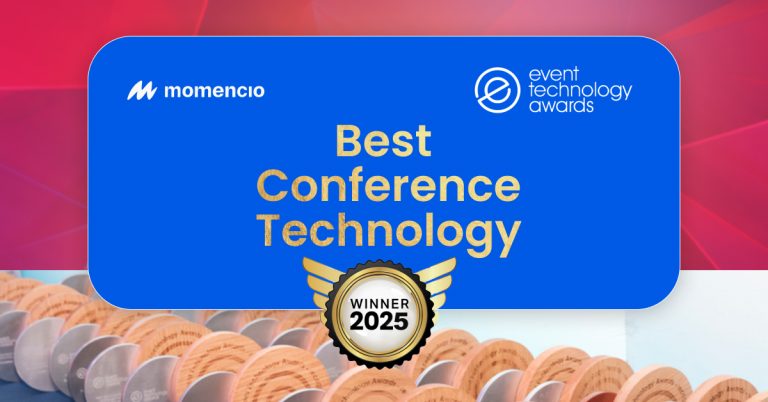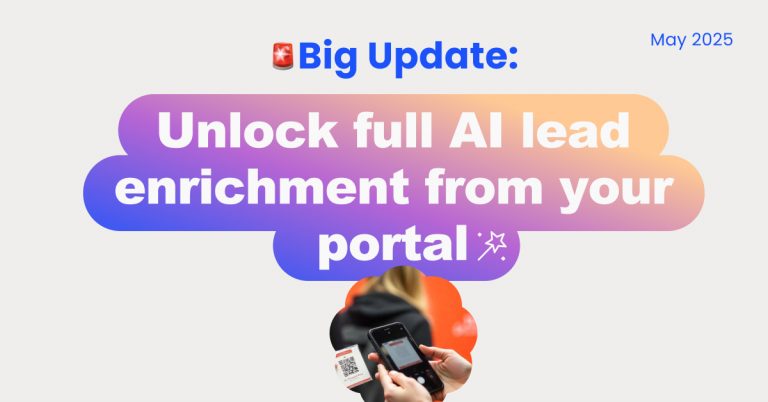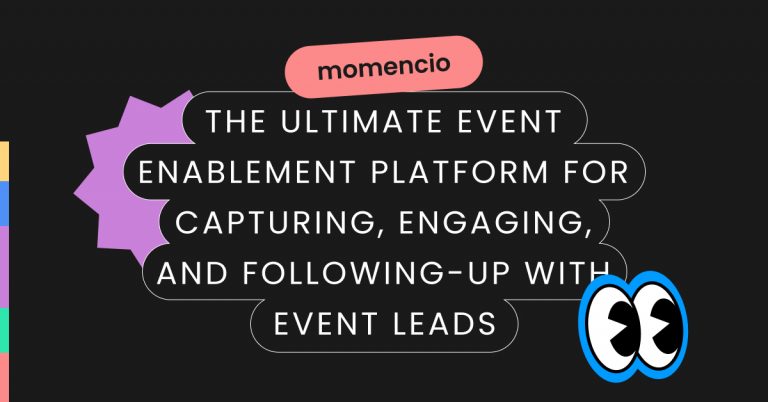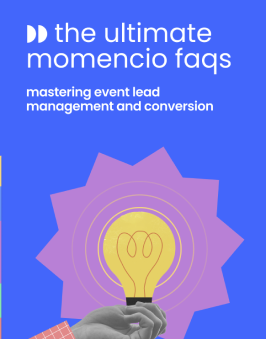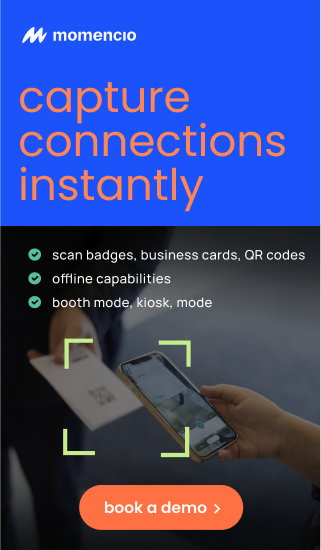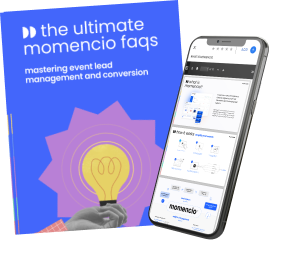The most valuable asset in your GTM engine isn’t your CRM. It’s not your ad budget, your outbound cadence, or even your content. It’s the data you own, and more specifically, the intelligence you generate from every prospect interaction. Essentially, it’s the event intelligence that holds the potential to remove the bottlenecks your sales team is currently facing, like not knowing which leads to prioritize, when to reach out, or what actually moved the needle in a deal.
And yet, for most organizations, this asset does not exist. Event leads are captured. Uploaded. Forgotten. Sales follow up based on gut feel, not buyer signals. Marketing struggles to attribute outcomes. And leadership — you — are left questioning whether the investment in events is producing anything meaningful.
That’s not a lead gen problem. It’s a data ownership problem.
In a post-cookie, AI-driven, privacy-regulated world, you can no longer rely on third-party insights to understand your buyers. Your competitive advantage will be built on what you know — first-hand — about your prospects. Their interests. Their intent. Their behavior. Their buying stage. All of it.
And if you’re not building this proprietary intelligence layer, you are not just behind — you’re blind.
This isn’t about capturing more leads. It’s about transforming each event interaction into a signal-rich data point — owned, tracked, and activatable across your pipeline. It’s about converting short conversations at the booth into long-term sales intelligence.
It’s about replacing lagging indicators with real-time behavioral visibility. And it’s about ensuring that your marketing and sales teams don’t just work harder, they work smarter, because they know more.
In this article, we’ll unpack why most organizations have a data leak disguised as an event strategy, and how momencio quietly transforms those leaks into a long-term, compounding first-party intelligence asset that belongs to you.
Why most companies are getting first-party intelligence wrong
The surface-level misunderstanding
In boardrooms and marketing meetings alike, the term “first-party data” is often used as a strategic talking point. Yet despite the growing emphasis on data privacy, platform independence, and personalization, most organizations still fail to understand what first-party intelligence actually entails.
Collecting basic lead information—names, emails, company names, job titles—is not intelligence. It’s identification. And while that data is necessary, it is not differentiating. It is not proprietary. And critically, it does not inform strategic decisions at a granular level.
Many businesses believe they “own their data” simply because they’ve gathered it through direct channels. But ownership alone does not equate to value. The true asset lies not in the existence of data, but in the depth, context, and behavioral signal attached to it.
Data versus intelligence: A strategic distinction
First-party intelligence is defined not by how much data you’ve collected, but by how effectively that data reflects intent. The difference is subtle but fundamental.
- Data tells you who the buyer is.
- Intelligence tells you how they think, where they are in the journey, what challenges they’ve verbalized, and how they engage with your brand across touchpoints.
For example, two event leads may carry identical titles and company sizes. But one engaged with a product demo, clicked through a feature guide, asked about integration capabilities, and responded to a follow-up email within 24 hours. The other simply stopped by the booth. Only one of these records reflects actual intent. Without intelligence, they’re treated the same.
This misclassification is costly. It leads to inefficient follow-ups, bloated pipelines, and poor conversion forecasting. Worse, it erodes the credibility of marketing-generated leads within sales organizations—turning event investment into a sunk cost rather than a revenue accelerator.
Why most systems fall short
The issue isn’t just awareness—it’s infrastructure.
Traditional CRM systems were not built to handle event-driven intelligence. They are designed to store fields, not interpret context. Lead capture forms and badge scanners, while useful for intake, are functionally passive. They do not collect behavioral nuance. They do not document live conversations. They do not track content interaction in real-time or synthesize patterns across multiple touches.
Even sophisticated marketing automation platforms rely heavily on retroactive engagement scoring, which rarely accounts for in-person activity. As a result, event leads often enter the system flat—lacking the signal strength needed to drive meaningful next steps.
Strategic implications for leadership
For decision-makers, the implications are clear. Without first-party intelligence:
- Sales teams are reactive, engaging based on guesswork instead of clear buyer signals.
- Marketing attribution suffers, limiting the ability to tie event investments to pipeline outcomes.
- Revenue forecasts become unreliable, as the activity logged doesn’t reflect true purchase readiness.
Organizations that do not evolve their data strategy around owned, behavior-based intelligence are not just leaving value on the table—they’re setting themselves up to be outpaced by competitors who are quietly compounding insight over time.
What first-party intelligence enables
When executed correctly, first-party intelligence becomes a self-reinforcing asset. Every interaction feeds the next. Every engagement becomes an input into a broader understanding of buyer intent. Over time, this creates a proprietary intelligence layer that competitors cannot replicate and third-party vendors cannot supply.
It enables:
- Precise lead prioritization based on actual behavior
- Hyper-relevant content delivery tailored to pain points discussed in real time
- Real-time visibility into buying signals that trigger proactive outreach
- Higher sales efficiency and shortened deal cycles
- Strategic clarity on what drives conversions at the intersection of people and moments
These are not theoretical benefits. They are measurable outcomes seen in organizations that treat intelligence as a strategic function—not a post-event formality.
The decision ahead
Owning first-party data is table stakes. Building intelligence from it is the competitive edge.
The companies that understand this distinction—and act on it—will outpace those that don’t. Not through more spend. Not through more outreach. But through deeper insight, sharper targeting, and a more intelligent system of growth.
The question for leadership is no longer do we have data? It’s do we know what to do with it—before our competitors do?
The data black hole of business events
Billions are spent. But where does the data go?
Global B2B event spend exceeds $30 billion annually. Companies invest in travel, booths, creative assets, sponsorships, and team bandwidth—all to engage the right audience face-to-face. Yet despite these investments, most organizations walk away from events with shockingly little to show for it in terms of actionable intelligence.
At best, they capture a list of scanned badges. At worst, they rely on manually transcribed notes, scattered business cards, or memory. In both cases, the signal is lost. And with it, the opportunity to build a strategic, owned data asset.
The real issue isn’t lead volume. It’s signal loss.
Ask most sales leaders what happens after a major trade show or conference, and the answer is almost always the same: a flurry of disorganized follow-ups, uneven results, and pipeline that rarely reflects the energy and intent seen at the event itself.
Why? Because the systems in place are optimized for collecting leads—not understanding them.
Here’s how signal loss happens:
- Badge scans capture presence, not intent: Someone visiting a booth doesn’t imply interest. Yet most post-event strategies treat all scans equally—leading to bloated pipelines and wasted outreach.
- Static CRMs strip out context: Even when reps take detailed notes, much of the nuance—questions asked, objections raised, moments of interest—is lost during manual entry. The human memory is unreliable, and most CRMs are built to store fields, not dialogue.
- Follow-ups are generic, not targeted: Without behavioral insights, sales teams default to generic messaging. Prospects who showed interest receive the same template as those who dropped by for swag. Engagement drops. Momentum fades.
- Marketing attribution becomes anecdotal: Events are high-touch experiences, but without clear behavioral tracking, marketing teams can’t accurately connect engagement to pipeline velocity. ROI becomes a matter of opinion, not data.
This cycle repeats itself quarter after quarter. The cost isn’t just inefficiency—it’s a missed opportunity to build a proprietary intelligence system from one of the most high-signal environments in the buyer journey.
What’s missing is infrastructure
Business events are not just lead-gen exercises. They are high-density intelligence collection opportunities—if the right infrastructure is in place.
Most event tech and CRM systems are built for intake, not insight. They’re good at storing names. They’re not designed to capture nuance, content interaction, or mid-conversation cues. And they don’t connect the dots across time.
What’s needed is a system that does three things exceptionally well:
- Captures context in real time — not just who the prospect is, but what was said, what was shared, and how they responded.
- Tracks post-event engagement — every click, scroll, video watch, download, or revisit across digital content.
- Feeds into a larger intelligence engine — so insights aren’t siloed by event, but compound over time to create a multi-touch profile of buying behavior.
Without this infrastructure, organizations are running high-cost programs with low-yield data—and losing ground to competitors who are building intelligence quietly and consistently in the background.
The executive takeaway
Events aren’t failing because they don’t work. They’re failing because the data strategy behind them is broken.
The difference between a lost lead and a closed deal often comes down to what was remembered, what was recorded, and what was tracked after the booth interaction ended. Right now, most companies are flying blind.
Those that solve this problem—those that treat every booth conversation, content interaction, and follow-up as a datapoint—will own their buyer understanding in ways competitors can’t replicate.
That’s not just an operational upgrade. That’s a strategic moat.
momencio — Your on-ramp to first-party intelligence
Intelligence isn’t built after the event. It starts at the booth
The conventional approach to event lead capture assumes that intelligence is something you build later—after the badge is scanned, after the CRM entry is created, after the follow-up email is sent.
momencio turns that logic on its head.
It starts with a simple premise: if intelligence is what drives revenue, it should be captured at the source—during the moment of engagement. Not reconstructed after the fact. Not inferred from generic scoring models. Captured, structured, and enriched in real time.
This philosophy is embedded across momencio’s event ecosystem. What looks like a lead capture app on the surface is in reality a high-resolution data layer designed to transform every booth interaction into long-term commercial advantage.
What sets momencio apart is its depth
Where traditional event tools stop at basic contact capture, momencio accelerates beyond identification into enrichment, context, and activation.
- AI enrichment: Every contact is instantly supplemented with AI enriched business intelligence—LinkedIn profile, accurate job title, company insights, and verified email—all within seconds of interaction via AI EdgeCaptureTM.
- Smart notes and speech-to-text capture: Instead of expecting sales reps to remember conversations or jot down fragmented notes, momencio enables them to log detailed, structured insights using voice—without breaking the flow of dialogue. Interests, objections, key challenges, and opportunity signals are captured live and synced directly into the system.
- Digital asset library: Collateral is no longer something you hand out and hope gets read. Within momencio, demo decks, videos, feature sheets, and walkthroughs are embedded directly into the sales workflow. Interactive content can be presented on the spot and tailored in real time to the conversation at hand.
From content to conversion: Personalized microsites at the booth
One of momencio’s most powerful features is its ability to create fully personalized microsites—built in seconds, at the booth, in front of the prospect.
Imagine this: a sales rep has a five-minute conversation with a qualified buyer. Based on the topics discussed and the buyer’s expressed interests, the rep selects relevant content—case studies, integration guides, pricing sheets, industry insights—and generates a custom landing page, unique to that buyer, on the spot. Before the conversation ends, the page is shared with the prospect via email.
It doesn’t stop there. momencio tracks every action taken on that page—clicks, scrolls, video plays, downloads, time spent on each asset. These interactions are logged as behavioral signals, scored automatically, and linked to the contact’s profile.
What begins as a single booth conversation quickly becomes a rich behavioral trail.
From moments to momentum: feeding intelligence into the system
The real value emerges after the event—when momencio’s integration capabilities come into play.
Whether your team uses Salesforce, HubSpot, or another CRM, momencio ensures that every enriched contact, every behavioral signal, every content interaction, and every conversation insight flows seamlessly into your sales infrastructure.
This turns your CRM into more than a database. It becomes a live intelligence engine.
Sales teams gain visibility not only into who a lead is, but how engaged they are, what they’ve responded to, and where they are in the decision-making process. Guesstimates are eliminated. Pipeline quality improves. And follow-ups are timed to align with actual buyer behavior—not artificial deadlines.
Marketing teams, meanwhile, gain a feedback loop that connects content strategy to real engagement data—allowing them to see which assets drive conversion, which topics resonate, and which prospects warrant continued nurturing.
Strategic shift, not tactical add-on
momencio isn’t an event tool. It’s a data strategy platform operating at the point of contact. It doesn’t ask you to change how you run events—it upgrades what you get from them.
For organizations serious about owning their buyer journey end-to-end, the shift to intelligence-driven infrastructure is not optional. It’s foundational.
And momencio is where that shift begins.
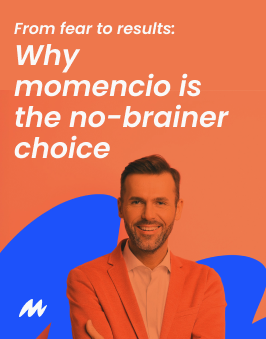
From booth to brain, every interaction leaves a trail
What happens after the handshake matters more than the handshake itself
Most organizations focus heavily on event execution—booth design, giveaways, team readiness—but neglect what happens after the conversation ends. The reality is that no matter how engaging the discussion was in person, what determines whether a lead progresses is the trail of digital behavior that follows.
In today’s buying landscape, interest is rarely linear. A prospect may leave your booth intrigued but not ready to engage. They’ll revisit your content later, share assets with stakeholders, or explore your solution on their own time. What matters is whether you’re able to see that journey—and act on it.
momencio is designed to turn each of these moments into data. Not just tracked, but interpreted. Not just recorded, but made actionable.
The microsite is the new follow-up
Generic emails sent days after an event are no longer effective. They arrive too late, lack relevance, and fail to reflect the specifics of the booth conversation.
momencio replaces that outdated playbook with an intelligence-driven follow-up mechanism: personalized microsites.
These microsites are not static landing pages. They are dynamically assembled from content repositories based on what the rep learns in real time. For a prospect who asked about implementation timelines, the site might include a deployment roadmap and customer onboarding video. For someone focused on integrations, it may feature technical documentation and partner ecosystem overviews.
The rep builds the site on the fly—within minutes—and shares it before the prospect even leaves the booth.
That speed isn’t just impressive. It’s strategic. It ensures that follow-up aligns with peak interest.
Every click, scroll, and view becomes insight
Once the microsite is delivered, momencio tracks every action taken on it. This includes:
- Time spent on each content module
- Scroll depth and heatmap data
- Click-throughs on CTAs or embedded videos
- Downloads of case studies, one-pagers, or technical guides
- Revisits and shares, including timestamps
These behaviors are not siloed in a dashboard. They are linked directly to the contact’s profile, scored in real time, and synced with your CRM or marketing automation system.
This transforms passive content consumption into measurable buying signals.
More importantly, it gives your sales team an unfair advantage: they know not just who engaged, but how they engaged, when they did it, and what they’re gravitating toward. That level of visibility turns guesswork into targeted action.
Engagement scoring that prioritizes precision over volume
One of the more common challenges post-event is pipeline bloat. Every scanned lead is entered into the system. Follow-up begins immediately. Yet only a fraction of those leads are ready, and even fewer are qualified.
momencio filters noise from signal through a behavioral scoring model. Instead of relying solely on static attributes like job title or company size, leads are prioritized based on their actual engagement—on the ground and afterward.
This allows your team to:
- Identify hot leads before the competition does
- Avoid chasing low-intent prospects with generic messaging
- Align sales outreach with actual buying behavior
- Focus resources where there’s real movement
It’s not about faster follow-up. It’s about smarter, better-timed follow-up.
Data is collected. Intelligence is compounding.
With every event, every interaction, and every piece of shared content, momencio is not just collecting data. It’s creating memory.
It’s building an internal record of how each individual prospect interacts with your brand across time. If the same buyer returns at the next event, your team sees the full timeline. If multiple stakeholders from the same company engage across touchpoints, that data is unified. What emerges is not just a lead database, but a behavioral graph—unique to your organization, proprietary to your process.
This is what long-term intelligence looks like: every interaction becoming input into a smarter system.
Making event data intelligence actionable
Intelligence that sits in a dashboard isn’t strategy
Capturing intelligence is only the first half of the equation. For it to drive revenue, intelligence must flow into your operating systems, inform your pipeline strategy, and enable real-time decisions across teams.
That’s where most data strategies fall short. They collect signals but fail to translate them into action. Sales is left out of sync. Marketing continues to nurture based on assumptions. Leadership sees top-of-funnel motion but lacks visibility into quality.
momencio was built to close that loop—by integrating intelligence into the systems where strategic decisions are made and executed.
Intelligence flows where your team already works
One of the core principles behind momencio’s platform design is systems alignment. Event intelligence should not live in a separate tool, buried in a post-event report or limited to marketing analytics. It should be visible—and usable—inside the platforms your team depends on daily.
momencio integrates directly with leading CRMs like Salesforce and HubSpot. But the depth of that integration goes far beyond contact sync.
Here’s what gets carried over in real time:
- Enriched lead profiles (LinkedIn, title, business email, company insights)
- Smart notes and conversation context from the booth
- Personalized microsite links and associated engagement data
- Behavioral scoring based on content interaction
- Time-stamped activity logs showing post-event touchpoints
This creates a full-funnel record of the lead journey—starting from the moment of first contact at the booth, extending through every piece of shared content, tracked interaction, and follow-up touchpoint.
Sales is no longer chasing cold leads. They’re acting on live intelligence.
From instinct to insight: sales visibility, redefined
When follow-ups are driven by data rather than gut feel, the entire sales process becomes more efficient.
Reps using momencio don’t just see a lead’s name in the CRM. They see that the lead downloaded a pricing document 24 hours after the event, rewatched a product demo twice, skipped the competitor comparison, and forwarded a technical guide to a colleague. That’s not static data. That’s behavior—and it signals urgency.
Sales managers, meanwhile, gain visibility into engagement health across their pipeline. Instead of relying on rep anecdotes to assess deal quality, they can see real-time intent signals that map directly to likelihood of conversion. This transforms forecasting from narrative-based to data-driven.
For CROs and revenue leaders, this level of visibility translates to more confident decision-making. Budget allocation, resource planning, and sales coaching can now be tied to behavior—not intuition.
Marketing becomes accountable to impact, not just impressions
For marketing teams, momencio offers a closed feedback loop that’s often missing in event programs. Every piece of content shared through a microsite is tracked. Every engagement is logged. And every influence on the buying journey is visible.
This enables a different kind of post-event analysis. Instead of asking “Did this event generate leads?” marketing leaders can ask:
- Which content assets saw the highest engagement from qualified buyers?
- What pain points did top prospects raise during conversations?
- Which interactions most reliably predicted conversion?
These insights don’t just validate the event. They inform future campaigns, content creation, and go-to-market strategy.
Marketing stops operating on intuition and starts optimizing based on precision.
Actionable means repeatable
The final, often overlooked advantage of actionable intelligence is repeatability.
When every step—capture, contextualization, enrichment, engagement, follow-up, and conversion—is logged and measured, event strategy shifts from experimental to systematic.
You now know what “high intent” actually looks like. You know which signals matter most. You know which interactions lead to pipeline velocity—and which don’t.
That means your next event doesn’t start from zero. It starts from intelligence. And that changes everything.
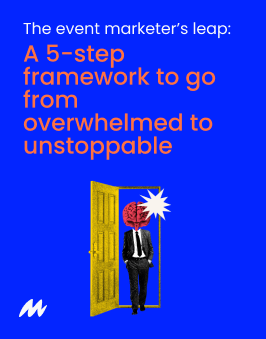
Building a proprietary first-party intelligence asset over time
Competitive advantage is no longer in access—it’s in accumulation
In the past, competitive edge came from market reach, budget, or early access to third-party databases. Today, those factors are increasingly commoditized. Your competitors can buy the same data, advertise on the same platforms, attend the same events.
What they can’t replicate is your proprietary intelligence—if you’re building it.
When first-party intelligence is captured intentionally and connected across time, it becomes more than event data. It becomes an organizational memory. A compounding, continuously enriched asset that sharpens your targeting, accelerates your sales cycle, and creates a feedback loop your competitors can’t buy.
This is the difference between a CRM filled with disjointed contact records and a living graph of buyer behavior that grows more accurate with every interaction.
From one-time interactions to longitudinal insight
Most organizations treat events as isolated moments. They run campaigns. They attend shows. They follow up. Then they start again from zero.
But buyer journeys rarely operate on clean timelines. A prospect who engages at Q1’s event may not convert until Q4. Another may attend multiple events, speak with different reps, explore various content assets, and interact with marketing campaigns over time.
If each of these engagements is tracked independently—or worse, lost entirely—your organization can’t recognize patterns. You can’t prioritize intelligently. And you can’t build an accurate model of what actual buying behavior looks like.
momencio solves this by linking all interactions to a single source of truth: the prospect’s behavioral profile.
Whether a lead attends one event or five, interacts with a single asset or engages repeatedly, the data is stitched together. Over time, the organization builds a detailed picture of:
- Topics the prospect has shown consistent interest in
- Content formats that drive engagement
- Sales objections raised and overcome
- Buying signals across multiple stakeholders within an account
- Timing patterns that indicate readiness
This isn’t lead tracking. It’s behavioral modeling—and it becomes more powerful with each new datapoint.
The emergence of an internal intelligence graph
As more interactions are captured, organizations begin to form what can only be described as an internal intelligence graph: a real-time, cross-touchpoint representation of how buyers move, think, and act.
This graph is not theoretical. It shows, with precision:
- Which pain points are most common among your ideal customer profile
- Which content combinations lead to conversion
- Which events or formats yield the most qualified interest
- Which types of behavior consistently correlate with sales velocity
The benefit is not just sharper execution. It’s future-proofing. AI tools, predictive models, and personalized campaigns all rely on dense, accurate first-party data to function effectively. Without a deep reservoir of clean behavioral data, automation remains generic—and personalization becomes guesswork.
But with an intelligence graph grounded in actual behavior, organizations can scale strategic decision-making with confidence.
Intelligence that stays in-house
Unlike third-party data, which is rented, temporary, and subject to compliance risks, first-party intelligence is owned. It is exclusive to your organization. It does not expire. It cannot be undercut by competitors.
This makes it a durable asset. One that holds its value across economic cycles, team transitions, and platform shifts.
It also means that the more you invest in capturing and structuring it now, the more control you retain later—when privacy regulations tighten, when third-party signals disappear, or when customer expectations for personalization become non-negotiable.
Strategic investment, not operational overhead
Too often, event data is treated as an operational task—something to be handled by field marketers or post-event coordinators.
But when approached with the right infrastructure, first-party intelligence becomes a long-term strategic asset—on par with your product roadmap, go-to-market motion, or talent pipeline.
It informs decisions across marketing, sales, partnerships, and executive leadership. It reduces cost per acquisition. It improves conversion. And it compounds.
That’s not reporting. That’s return on intelligence.
Why this matters more than ever (and what’s coming next)
The urgency around first-party intelligence isn’t theoretical. It’s driven by tangible shifts in data policy, buyer behavior, and go-to-market economics. The window to act early is closing fast—and the organizations that delay will find themselves playing from behind.
Below is a strategic foresight brief breaking down the key forces accelerating the need for a proprietary first-party intelligence infrastructure.
The death of third-party signals is not on the horizon. It’s already happening.
With Google phasing out third-party cookies, Apple limiting cross-domain tracking, and data brokers under growing scrutiny, the era of renting buyer insight is over. Visibility is narrowing across every major channel. Platforms that once supplied intent data are going opaque—and with them, attribution, targeting, and retargeting strategies are collapsing.
The companies still relying on third-party overlays for segmentation or intent detection are already flying blind. Without owned behavioral signals, personalization becomes impossible, and automation breaks down.
Privacy regulations are forcing strategy shifts, not just legal compliance.
GDPR, CCPA, LGPD, and other frameworks are not just legal checkboxes. They represent a fundamental shift in how organizations must approach data collection and storage.
Marketing and revenue leaders must now assume that any data not captured directly, consensually, and transparently may soon be off-limits. This makes every event, every touchpoint, every owned channel an increasingly valuable opportunity to collect compliant, high-fidelity data.
The organizations that treat first-party intelligence as a legal necessity alone will remain reactive. Those that treat it as a strategic differentiator will move first—and stay ahead.
AI will widen the gap between companies with signal density and those without it.
The effectiveness of AI in sales and marketing depends on the quality of the data it’s fed. Personalization, predictive scoring, lead routing, conversation intelligence—none of these systems function without granular, time-stamped behavioral signals.
This is the new arms race.
Organizations that feed their AI models dense, contextual, first-party intelligence will unlock precision workflows that drive revenue without increasing headcount. Those without such data will find their AI investments underperforming—because the systems are guessing, not learning.
Buyer behavior is increasingly nonlinear. Only connected intelligence can keep up.
Modern B2B buyers are self-directed. They come in and out of the funnel, engage anonymously, research on their own timeline, and interact with multiple channels before ever speaking to sales.
This means capturing data in a static, one-time fashion—like a badge scan or a lead form—is no longer sufficient.
You need to track how that buyer engages over time, across assets, across campaigns, across events. Without an infrastructure that connects these behaviors and compiles them into a coherent profile, you’re left with fragments. And fragments don’t convert.
Strategy will bifurcate those who own their intelligence and those who rent insight
In the next 12–24 months, B2B go-to-market strategies will split into two camps.
- Organizations that own their intelligence. They will act with speed, precision, and relevance. Their sales cycles will shorten. Their marketing efficiency will rise. Their AI models will outperform.
- Organizations that rely on indirect signals and third-party proxies. They will see declining conversion rates, rising costs, and increasing friction in every campaign.
The difference between the two won’t be budget. It will be ownership.
What’s coming next
The next frontier is not more automation. It’s better intelligence.
Not more leads. More qualified signals.
Not bigger tech stacks. Smarter ones.
Organizations that act now, by building structured, integrated, first-party intelligence across their event ecosystem—will not just adapt to this shift. They’ll benefit from it.
They’ll create an internal advantage that compounds with every interaction.
And they’ll be the ones rewriting the benchmarks their competitors are still chasing.
You are not just collecting leads. You are building a strategic asset.
The business case for investing in first-party intelligence infrastructure isn’t a marketing conversation. It’s a strategic conversation. One that directly impacts sales velocity, pipeline accuracy, customer insight, and long-term competitive differentiation.
This is no longer about fixing a broken event follow-up process. It’s about redefining how your organization captures value from real human interactions—in a world where rented data is disappearing, and buyer behavior is more fragmented than ever.
Here’s what leadership needs to walk away with.
First-party data ≠ first-party intelligence
If your CRM is filled with contact records but empty of behavioral signals, you’re not sitting on an asset. You’re holding a directory. Real intelligence comes from:
- Capturing live engagement and contextual insights
- Tracking behavior across digital content and microsites
- Scoring intent based on actual buyer activity
- Linking all of it to pipeline in real time
That’s when data becomes useful. And defensible.
Event ROI cannot be measured without visibility
Events are high-touch investments. But when data flows are broken, the impact is anecdotal.
You need visibility into what your buyers did, said, downloaded, viewed, and followed up on. If you can’t see that, you can’t scale what worked—or fix what didn’t.
Leaders must demand infrastructure that gives them that line of sight. Otherwise, events will remain high-cost gambles with unpredictable outcomes.
Your pipeline is only as smart as your signals
Chasing every lead the same way is no longer acceptable.
If a lead received personalized content and interacted deeply with it, that behavior should trigger a different response than a passive booth visitor. The absence of this intelligence leads to missed opportunities, wasted sales effort, and forecasting you can’t rely on.
Intelligence must be captured upstream to create control downstream. That’s how winning revenue teams now operate.
Your data strategy is your go-to-market strategy
Your team may be equipped with modern tools, but if they’re working with flat data, they’re operating on instinct—not insight. That becomes a cost center disguised as efficiency.
Strategic leadership understands this. They don’t see intelligence capture as a reporting function. They see it as a force multiplier across departments.
- Marketing knows what’s resonating.
- Sales knows who’s ready.
- RevOps knows what’s moving the needle.
- The board sees real ROI attribution.
This isn’t theory. This is infrastructure—and it’s available.
What momencio enables isn’t event automation. It’s data ownership.
momencio doesn’t ask your team to do more. It helps you extract more from what you’re already doing. It builds the connective tissue between touchpoint and pipeline, behavior and prioritization, interaction and insight.
Every microsite opened. Every document downloaded. Every question asked. All of it captured, scored, and synced to your system of record.
What you’re left with is a complete, evolving intelligence asset—unique to your organization. And completely owned by it.
Final thought
You can keep treating events as lead-generation exercises. Or you can start treating them as intelligence operations.
You can keep collecting data that sits in silos. Or you can activate insights that compound over time.
The organizations that will win are those building proprietary knowledge from owned experiences. Not once. Not quarterly. But continuously.
momencio gives you the infrastructure to do exactly that.
The question is not whether you’ll need it. The question is how far ahead your competitors will be by the time you build it.
From insight to action
If your event strategy is built around lead volume, you’re chasing noise. If your CRM is filled with names, not behavior, you’re making decisions in the dark. If your data disappears after the booth interaction, you’re not building an asset — you’re burning opportunity.
You don’t need more tools. You need infrastructure. You need ownership. And most of all, you need signal clarity in a market that’s only getting louder.
Whether you lead marketing, sales, or revenue operations, the next strategic step is not more activity — it’s more intelligence.
Here are three places to start:
- Audit your current event data flow: Where does intelligence drop off? Where are signals lost? What can’t you see that you should?
- Benchmark your behavioral visibility: Are your teams acting on real-time signals or relying on best guesses? Does follow-up align with engagement or calendar reminders?
- Ask: What would be different if your data worked harder than your team? Not in theory. In the next quarter.
momencio is built for leaders asking these questions seriously. If that’s you — we’ll meet you where you are.
You’re not here to chase leads. You’re here to build leverage. And leverage begins with intelligence you own.
Book a free demo to see momencio in action.
FAQs
- How is momencio different from traditional event lead capture tools?
- momencio goes beyond basic lead capture by not only collecting contact information, but also enriching it instantly with verified business data like LinkedIn profiles, job titles, and emails. It captures contextual insights from conversations using speech-to-text smart notes, tracks digital engagement through personalized content microsites, and scores prospect behavior in real time. Traditional tools stop at collection; momencio builds an intelligence layer around every lead.
- Does momencio integrate with CRM platforms like Salesforce or HubSpot?
- Yes, momencio integrates directly with both Salesforce and HubSpot. The integration is bi-directional and supports syncing of enriched lead profiles, engagement activity, custom notes, behavioral scores, and follow-up actions. This allows sales and marketing teams to access all event-driven intelligence directly within their existing CRM workflow without additional manual effort.
- What kind of behavioral data does momencio track post-event?
- Once a prospect receives personalized content through a momencio-generated microsite, the platform tracks every action they take. This includes content views, scroll depth, time spent on page, downloads, video plays, revisit frequency, and email engagement. All these signals are logged against the prospect’s profile to inform follow-up strategy and sales prioritization.
- Is the data collected through momencio compliant with privacy regulations?
- Yes, momencio is designed with compliance in mind. All data captured is first-party, consent-driven, and tied directly to interactions at company-owned booths or interactive experiences.
- Can sales teams personalize follow-ups using momencio?
- Sales reps can instantly create personalized microsites based on live booth conversations. These sites include only the content relevant to the prospect’s interests—such as case studies, pricing decks, product walkthroughs, or technical documents. The microsite can be sent via email on the spot, and any further engagement with that content is tracked in real time, allowing the rep to follow up based on actual behavior.
- Does momencio support long-term intelligence building across multiple events?
- Yes, momencio connects data across all touchpoints and events, linking them back to each contact’s profile. This allows companies to build a complete behavioral history over time, including prior conversations, content engagement trends, and sales progression. It helps teams identify patterns, improve targeting, and measure the cumulative impact of event marketing on revenue.
Interesting facts from research
- Organizations leveraging customer behavioral insights outperform peers by 85% in sales growth and more than 25% in gross margin.
- B2B customers use an average of ten interaction channels in their buying journey, emphasizing the need for seamless omnichannel experiences.
- Integrating CRM systems across business functions enhances customer insights, streamlines sales processes, and fosters stronger customer relationships.
